technology
How an IT Strategy Can Boost Your Not-for-profit's Impact
Published: June 5, 2025
Read Time: 6 minutes

Why you need to align your technology investments with your strategic plan…
I asked my new client for a copy of their strategic plan. It was beautiful!
Full-colour, professionally formatted: a one-pager and a more detailed plan that broke down the key objectives into major activities.
A single bullet point buried in those pages of activities caught my eye: “Technology to support our business needs.”
“Can I see the plan behind this tech activity?” I asked.
“Hmmm… what do you mean?” My client was very confused. They never had a plan or a strategy for technology. They had written a generic statement, knowing it was important, without considering what it meant to implement.
Instead, like many other Not for Profits each year, they budgeted about the same amount for IT as the previous one.
On a rare occasion, they would make a major investment to replace a system, but that was often forced upon them by a vendor – not necessarily because of strategic decisions.
Your organisation is dependent on technology
Regardless of mission and purpose, today’s Not for Profit (NFP) is just as dependent on technology as its for-profit sisters. Think about it…
How would your organisation manage its operations if the internet or a major system went down for 24 hours?
How would you take a payment? Communicate with stakeholders? Document services you provide for clients? Make payroll?
Most NFPs would struggle if they had to perform these and other daily tasks manually. Yet technology is often considered a utility rather than a strategic investment - just another expense that can be cut when budgets are tight.
That’s often when tech becomes a risk.
When IT becomes a risk
A few years ago, I worked with an NFP client who just had a major cybersecurity breach. After the forensic work was completed, the report loudly screamed…
“This incident could have easily been prevented with some basic IT investments over the years!”
Instead, their IT was running on fumes. Unfortunately, this scenario is something I see too often.
Board members say cybersecurity is a high risk and priority for them (thanks to plenty of board education), but staff often don’t know how to reduce the risk with the tools and knowledge they have.
On top of this, important IT investments are considered nice to have. The best they can do is hope. Yet… hope does not mitigate risks.
My client’s board finally understood that they needed to make some IT investments fast, but where and how much would it cost?
The goals of technology investments in Not-for-Profits
I remember my first week as the new CEO of a charity after many years in the IT sector, working with big businesses and government clients. I asked the admin person for some pens and Post-it notes. She gave me exactly two pens and one pad.
I knew then that this was not an organisation that wasted money. This is also true for IT investments in almost all NFPs.
When they finally make an IT investment (strategic or otherwise), the goals usually fall into these categories:
- Improve customer/stakeholder experience
- Improve staff/volunteer experience
- Reduce manual processes
- Reduce costs
- Increase revenue
- Add functionality
- Improve decision-making through better reporting, dashboards and analytics
- Reduce risks
If an IT investment doesn’t achieve at least one of these, there is no business case.
What about innovation as an IT investment goal?
Volunteer board members from other sectors can wreck IT strategies when they believe the NFP is as technically mature and efficient as their workplace.
Their visions of innovation can cloud the organisation’s most basic needs and delay critical investments as a result.
“We’re waiting to make a CRM investment until we can see what’s happening with AI.”
I heard this statement from board members of two different NFPs at a conference last year. They were waiting for AI advances to make investment decisions. In the meantime…
Their staff spent hours each month manually manipulating spreadsheets to meet government reporting requirements for funding. Furthermore, the vendor no longer supported their system, creating huge cybersecurity risks!
NFPs must first meet the most basic IT requirements before they can make innovation itself a priority.
Until then, it’s imperative to create an IT strategy that recognises where the organisation is now to make that future state leap attainable in the next 3-5 years.
What is an IT strategy?
This leads to the IT strategy.
An IT strategy is a plan that outlines how the organisation will use technology to achieve its mission and goals. However, it is not just a wish list of IT projects or systems. Instead, it is a strategic document that links the organisation’s vision, values, and objectives with the technology solutions that will enable and enhance them.
To help determine this, you need to understand not only where the organisation is going but also where it is today. The gap between the current state and the future is essentially your plan or Roadmap.
The diagram (Figure 1.) shows how I see the relationship between your organisation’s strategic vision and goals and the existing enterprise architecture.

How do you create an IT strategy that supports your strategic plan?
Creating an IT strategy that supports your strategic plan is not a one-off exercise or a one- size-fits-all solution. It requires a systematic and iterative process that involves the following steps:
- Review your strategic plan and identify the key objectives that depend on or can be enhanced by technology.
- Analyse your current IT assets and needs to identify pain points or areas for improvement.
- Research and evaluate the available solutions that can address your pain points and support your strategic objectives.
- Develop a roadmap that prioritises the IT initiatives over the strategic period (3-5 years).
- Estimate the budgets and resources required.
- Establish a governance structure with roles and responsibilities to oversee and make relevant decisions related to IT investments.
- Implement and monitor the IT initiatives.
- Measure their outcomes and benefits.
- Communicate the progress and results to stakeholders.
The IT strategy should also be reviewed as part of the annual planning and budget cycle to determine whether priorities have changed. Once that is determined, the indicative budget of each prioritised initiative for a financial year can be presented for funding consideration systematically.
Conclusion
Despite their heavy dependency on technology, few NFPs have IT strategies to support their organisational strategic plans. When IT is treated like a utility that can be cut when budgets are tight, it quickly becomes a significant risk to the organisation. However, NFPs that invest in technology as an enabler can reap significant benefits to support their missions.
The IT strategy is the key to achieving this and ensuring that technology investments are aligned with the organisation’s strategic plan, enabling it to maximise its impact and achieve its goals.
This article was first published in the 2024 Better Boards Conference Magazine.
Further Resources
Cybersecurity – Is This a New Directors’ Duty?
Technology for Innovation and Development
Share this Article
Recommended Reading
Recommended Viewing
Author
-
IT Advisor for NFP Sector
Roundbox Consulting
- About
-
Twenty-five years ago, Tammy Ven Dange helped a client set up a new charity to support military veteran organisations. Since then, she’s remained heavily involved in the Not for Profit (NFP) sector while concurrently working in the IT industry for much of her career.
Tammy has started two NFPs, been on the Board or Advisory Committee for six, facilitated many strategic planning sessions most recently was the CEO of a charity.
As for IT, Tammy entered the industry as a project manager for the NASA SAP implementation in 2001. Her last corporate job in the sector was Head of the Public Sector for an Australian IT company.
Today with her business, Roundbox Consulting, she helps Not for Profits make strategic IT decisions, especially around investments on the selection of an individual solution or a full transformation roadmap that includes a review of their entire enterprise architecture.
Found this article useful or informative?
Join 5,000+ not-for-profit & for-purpose directors receiving the latest insights on governance and leadership.
Receive a free e-book on improving your board decisions when you subscribe.
Unsubscribe anytime. We care about your privacy - read our Privacy Policy .









